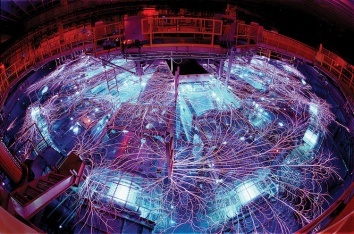22.04.2018

Astrophysicists will conduct experiments designed to re-create the physical environment inside stars, with a new $7 million grant that the Department of Energy’s National Nuclear Security Administration (DOE/NNSA) has awarded to The University of Texas at Austin. This work could help astronomers reduce uncertainties about the sizes and ages of super-dense objects known as white dwarf stars.
The DOE/NNSA grant, distributed over a five-year period, will allow the university to establish a new Center for Astrophysical Plasma Properties (CAPP), which aims to advance astronomy through experimental science. Researchers from the center will conduct “at-parameter” experiments, meaning experiments conducted under the same extreme temperatures and densities found inside stars. Using the Z-machine, the world’s most powerful X-ray source, based at Sandia National Laboratories, the team will replicate the extreme temperatures and densities of plasma, the stuff inside stars.
“Here, if we want to study a white dwarf whose surface is at 15,000 degrees, then we’re doing the experiment at 15,000 degrees,” said Mike Montgomery, deputy director of CAPP and clinical researcher in the Department of Astronomy. “It is really like taking a piece from the Sun and looking at it under a microscope.”
“The really amazing thing about this research is that it changes the way astronomy has been conducted in the past,” said Don Winget, the director of CAPP and a professor in the Department of Astronomy. “There were a lot of things we thought we understood, or knew we didn’t understand in astrophysics. By re-creating those conditions and making real measurements in the laboratory, we’re changing how we think of not only astronomy as a field, but how we think of specific astronomical objects.”
Traditional astrophysics has largely been an observational science, and experiments are usually conducted at magnitudes much smaller than those observed in the cosmos. This has often led to discrepancies between the experiments and observations, Winget said.
These discrepancies have been noticed when calculating the mass of white dwarfs, which are the dense core remnants of “dead” stars. The mass often differs by 10 to 15 percent when measured using different methods. When astronomers try to use white dwarfs to calculate the ages of galaxies, this error translates to an uncertainty of a few billion years.
The center will explore these discrepancies and seek to improve current models using data obtained from these experiments. The grant will support four graduate students and two postdoctoral researchers. The center also brings together experts in various areas of astrophysics from UT Austin, the University of Nevada, Reno, and Sandia National Laboratories.
“Right away, we hit the ground running because we have these people involved, broadening our range of research,” Winget said. “With the center, we’re able to have these interactions and bring new people into laboratory astrophysics.”
“Now, we’re going back and asking very fundamental questions,” Winget said. “Instead of doing calculations, we’re doing experiments and checking. We’re going to learn a lot of things we plan on learning, and we’re going to learn a lot of things that we had not planned on learning.”
+++
Emulating Stars

Credit: Randy Montoya
Traditionally, astrophysics has been a science of observations, not experiments. How in the world (literally) can researchers conduct tests involving celestial bodies hundreds of light years away, far hotter and denser than anything on our planet?
It sounds impossible, but researchers in The University of Texas at Austin’s Department of Astronomy conduct experiments that recreate the physical conditions of stars. To replicate the extreme temperatures and densities of plasma, the stuff inside stars, astronomers Don Winget and Mike Montgomery are leading a team that makes use of Sandia National Laboratories’ Z Machine, the world’s most powerful laboratory generator of X-rays.

Electricity charges massive capacitors, which store and then release charges in microseconds. The capacitors compress the electricity into tight pulses, flowing into containers holding gas.

The gas is ionized with lasers, further compressing pulses into finer spaces and shorter increments of time.

Finally, the electricity flows into a delicate array of tungsten wires clustered together in a central compartment the size of a spool of thread.

For just nanoseconds, the X-ray energy generated by the magnetically imploded plasma is far greater than all the energy released by all the power plants in the world.
The result is a tiny chunk of a star.
Watch to see more on the team making star stuff and how they inspired one artist’s recent work.
